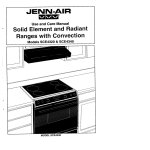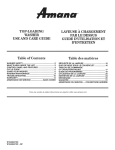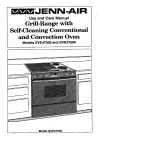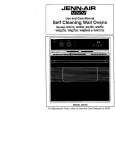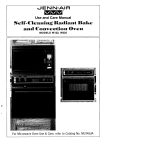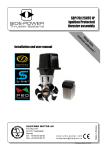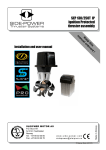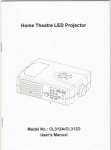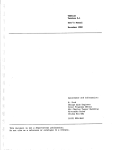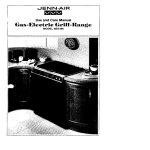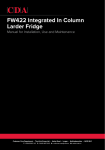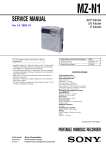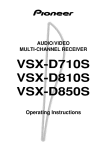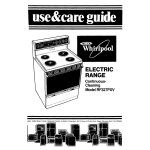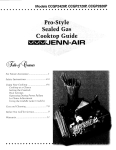Download Jenn-Air W206 User's Manual
Transcript
_J E N N-AI
R
Use and Care Manual
Self-Cleaning
Wall Ovens
MODELS W106, W136, W206, WM227, WM236
ForWM227
&WM236
Microwave
Oven,
refer
toUse
andCare
Manual
forM167.
About YourOven
Jenn-Air
Congratulations on your choice of a Jenn-Air wall oven.
Your Jenn-Air convection oven combines the best of two cooking methods,
convection and radiant bake (conventional) baking or roasting. (Note: Only Models
W136, W206, WM227, WM236 have the convection option.)
The Jenn-Air convection oven is actually a conventional oven that circulates heated
air within the oven. As both bake and broil heating elements cycle on and off
with the thermostat, a fan keeps the heated air circulating around the food.
The constantly recirculating heated air in the convection oven strips away the
layer of cooler air that surrounds food. Consequently, many foods cook more quickly.
Evenly distributed heat makes multiple rack cooking possible. Convection roasted
meats retain their natural flavor and juiciness with less shrinkage than radiant bake
roasting.
In addition to the many exclusive benefits of convection cooking, your JennAir oven is also a fine full-featured "bake and broil" oven.
You can cook your "old favorite" recipes as you have in the past. The radiant
bake oven also gives you the flexibility of preparing various foods when convection
cooking may not be as beneficial, as when cooking foods in covered casseroles
or clay pots.
The broil element is convenient for top browning and oven broiling of foods.
The time bake feature can be used with either the convection or radiant bake
oven.
Since this manual explains how you can obtain the best use of your oven, it
is essential that you follow the instructions carefully. This will enable you to fully
enjoy and properly maintain your denn-Air oven and will also assure you of achieving
the finest cooking results with the foods you prepare.
"Complete Cooking with Jenn-Air" cookbook features outstanding recipes and
cooking tips you'll enjoy using with your new Jenn-Air wall oven. A big section
on oven baking contains instructions for both convection and conventional baking
of each recipe. The cookbook also contains information on using a Jenn-Air grill
and the various cooktop accessories. Our deluxe hardcover edition is composed
of over 400 recipes with hundreds of food and "How to do it" photos (Model A905).
NOTE: Use the information in this use and care as guidelines for rack positions,
times, and settings when using the recipes in the cookbook.
Should you have any questions about using your Jenn-Air appliance, write to
us. Be sure to provide the model number of your appliance.
Consumer Relations Department
Jenn-Air Company
3035 Shadeland Avenue
Indianapolis, IN 46226-0901
SAFETY
PRECAUTIONS
Read before operating your oven
All appliances -- regardless of the manufacturer -- have the
potential through improper or careless use to create safety
problems. Therefore the following safety precautions should
be observed:
1. Be sure your appliance is properly installed and grounded
by a qualified technician.
2. Never use your appliance for warming or heating the room.
3. Children should not be left alone or unattended in area
where appliance is in use. They should never be allowed
to sit or stand on any part of the appliance.
4. Wear proper apparel. Loose-fitting or hanging garments
should never be worn while using the appliance.
5. Do not repair or replace any part of the appliance unless
specifically
recommended
in this manual. All other
servicing should be referred to an authorized Jenn-Air
Service Contractor.
6. Flammable materials should not be stored in an oven.
7. Do not use water on grease fires. Smother fire or flame
or use dry chemical or foam-type extinguisher.
8. Use only dry potholders. Moist or damp potholders on
hot surfaces may result in burns from steam. Do not let
potholder touch hot heating elements. Do not use a towel
or other bulky cloth.
9. Use care when opening oven door. Let hot air or steam
escape before removing or replacing food.
4
10. Do not heat unopened food containers. Build-up of pressure may cause container to burst and result in injury.
11. Keep oven vent ducts unobstructed.
12. Always place oven racks in desired location while oven
is cool. If rack must be moved while oven is hot, do not
let potholder contact hot heating element in oven.
13. Do not clean door gasket. The door gasket is essential
for a good seal. Care should be taken not to rub, damage
or move the gasket.
14. Do not use oven cleaners. No commercial oven cleaner
or oven liner protective coating of any kind should be
used in or around any part of the oven.
15. Clean only parts listed in this manual.
16. Before self-cleaning
other utensils.
the oven, remove broiler
pan and
17. Listen for fan. A fan noise should be heard during the
broil and cleaning cycles. If not, call a serviceman before
self-cleaning again.
18. DO NOT TOUCH HEATING ELEMENTS OR INTERIOR
SURFACES OF OVEN. Heating elements may be hot even
though they are dark in color. Interior surfaces of any
oven become hot enough to cause burns. During and after
use, do not touch, or let clothing or other flammable
materials contact heating elements or interior surfaces of
oven until they have had sufficient time to cool. Other
surfaces of the appliance may become hot enough to
cause burns-among these surfaces are: oven vent
openings and surfaces near these openings, oven doors,
windows of oven doors.
IMPORTANT SAFETY NOTICE AND WARNING
The California Safe Drinking Water and Toxic Enforcement Act of
1986 (Proposition 65) requires the Governor of California to publish
a list of substances known to the State of California to cause cancer
or reproductive harm, and requires businesses to warn customers of
potential exposures to such substances. Users of this appliance are
hereby warned that when the oven is engaged in the self-clean cycle,
there may be some low level exposure to some of the listed substances,
including Carbon Monoxide. Exposure to these substances can be
minimized by properly venting the range to the outdoors during the
self-clean cycle.
Oven
Oven
Operation
Control
Panels
Indicator
Lights:
Oven light switch
Temperature
knob
Selector knob
Clock controls and minute timer
Door lock lever
Models W106, W136, WM227, WM236
Lower oven
selector knob
Lower oven
indicator light:
Upper oven
Lower oven
light switch
temperature knob
Upper oven indicator lights:
Bake
Bake
Lock
Clean
Lower oven
light switch
Door lock lever
Upper oven
selector knob
Upper oven
temperature knob
Model W206
6
Clock controls and
minute timer
Oven
Light
Switch
• Push in switch to turn oven light on or off. Light cannot be turned on during the
self-cleaning process. For some models, the oven light automatically comes on
whenever the oven door is opened.
Selector
Knob
• This knob controls the oven operation. To operate the oven, turn to desired setting,
then turn TEMPERATURE knob to desired setting.
The
settings
OFF
are:
The oven will not operate when knob is on this setting. Keep knob
on this position when oven is not is use.
Use for radiant bake (conventional) baking or roasting.
BAKE
TIME BAKE
Use with clock controls for automatically starting and stopping
oven when baking or roasting in the radiant bake oven.
Use for convection baking or roasting (Selected Models Only).
CONVECT
TIME CONMECT
Use with clock controls for automatically starting and stopping
oven when baking or roasting in the convection oven (Selected
Models Only).
BROIL
Use for top browning or oven broiling of foods.
CLEAN
Use for self-cleaning process.
Temperature
Knob
• Use to set oven temperature. Be sure the indicator square is in line with the exact
temperature desired. This knob is used with all oven operation settings noted on
the SELECTOR knob.
Bake
Indicator
Light
• Indicates when oven is turned to an operating position other than the CLEAN setting.
Light will glow until the desired temperature is reached. It will cycle on and off
as this temperature is maintained during cooking.
Lock
Indicator
Light
• Will glow after the oven door has been locked and after the oven temperature is
over 550°F. Door will lock automatically and cannot be opened until oven temperature
drops below 550°F.
Clean
Indicator
Light
• Indicates when all controls have been properly set for the self-cleaning
Light will remain on during the entire cleaning process.
Clock
Controls
and
Minute
process.
Timer
• Features time of day, MINUTE TIMER, and clock controls to start and stop oven
automatically. (See pages 8-11.)
Door
Lock
Lever
• Use to lock oven for self-cleaning
process.
Clock
Controls
INDICATOR WORDS
DISPLAY WINDOW
/
12 HOUR
TIME OF DAY CLOCK
MINUTE AND SECOND
TIMER
KEY: • Dot means to push.
•- Dash means to hold.
Clock
Setting
IMPORTANT: The clock is a 12 hour clock. When oven is first supplied power or power
is interrupted, the display will show "00:00".
To set time
of day on clock:
1. Turn SET dial counterclockwise until the word TIME appears in the Display Window.
Then, turn the SET dial in either direction until the correct time appears in window.
2. Push ENTER button.
To change time of day set on clock:
Repeat above sequence.
To cheek time of daywhen timer is in use: Push ENTER button. Time of day
will be displayed briefly, then display will return to timer function.
Minute
Timer
IMPORTANT: This interval timer can be used to remind you when a period, up to 99
minutes and 00 seconds, expires. It can be used independently
of any other oven
activity and can be set while another oven function is operating. The timer does not
control the oven.
To set
ML_U31_
TIMER:
1. Turn SET dial clockwise until desired number of minutes and seconds appear in the
Display Window.
EXAMPLE:
Turn the dial to 5 for 5 seconds or to 5:00 for 5 minutes.
IMPORTANT: This is the only function where time entered is in minutes
seconds. Minutes are to the left of colon and seconds to right of colon.
and
DISPLAY
5 SECONDS
5 MINUTES
2. Push ENTER button.
The indicator word TIMER will remain in Display Window during countdown. Countdown will have display precedence over anything else programmed, such as TIME
BAKE. At end of time set, the indicator word TIMER will blink and timer will beep.
Beeping will continue every 10 seconds for 15 minutes unless the CANCEL button is
pushed once. After CANCEL button is pushed, Display will return to time of day or
whatever is programmed on control panel.
To cancel
MINI_T1E TIMER:
Push CANCEL button once. Pushing
button twice will cancel all programming (time bake or self-clean).
CANCEL
Clock-Controlled
To sel
oven
Baking
or Roasting
to star/immedialely
and
shut
off automatically:
1. Turn SELECTOR knob to TIME BAKE or TIME CONVECT (Selected Models Only).
2. Turn TEMPERATURE
knob to desired temperature,
3. Hold in STOP TIME button until the indicator words STOP TIME appear in Display
Window.
4. Turn SET dial to time you want food to stop cooking.
EXAMPLE" If time of day is one o'clock and the roast needs to cook for 3 hours, the
stop time would be four o'clock.
I.FI f'l
I.U U
DISPLAY
TIME OF DAY
5. Push ENTER button to enter stop time.
STOP TIME
The indicator word AUTO will appear in the Display Window and oven will start
heating. The BAKE indicator light will glow until the desired temperature is reached.
When stop time is reached, the oven shuts off and the indicator word AUTO will
begin to blink and timer will beep. Beeping will continue every 10 seconds for 15
minutes unless the CANCEL button is pushed twice.
To sel
oven
to start
at future
time
and
shut
off automatically:
1. Turn SELECTOR knob to TIME BAKE or TIME CONVECT
2. Turn TEMPERATURE
(Selected Models Only).
knob to desired temperature.
3. Hold in START TIME button
Display Window.
until the indicator
words START TIME appear
in
4. Turn SET dial to time you wish food to start cooking.
EXAMPLE: If time of day is 11:30 and the roast needs to start cooking at one o'clock,
turn dial until numbers 1:00 appear in display.
l:3r_l
DISPLAY
TIME OF DAY
START TIME
5. Push ENTER button to enter start time.
The indicator words STOP TIME will appear in Display Window as a reminder to set
STOP TIME.
6. Turn SET dial to time you want food to stop cooking.
EXAMPLE: If start time is one o'clock and the roast needs to cook for 3 hours, the
stop time would be four o'clock.
DISPLAY
START TIME
STOP TIME
10
7. Push ENTER button to enter stop time.
The indicator word AUTO will blink in the Display Window. When start time
is reached, the indicator word AUTO will remain in Display Window. The BAKE
indicator light will glow until the desired temperature is reached.
When stop time is reached, the oven shuts off and the indicator word AUTO will
begin to blink and timer will beep. Beeping will continue every 10 seconds for 15
minutes unless the CANCEL button is pushed twice.
To check
ST,U{T
TIME before
Cooking
begins:
Hold in START TIME
button until the words START TIME appear in the Display Window. The start time will
be displayed briefly, then Display will return to time of day.
To change
START
TL_IIE before
cooking
begins:
1. Hold in START TIME button until the words START TIME appear in the Display
Window.
2. Turn SET dial to desired time.
3. Push ENTER
programmed.
button
twice to enter new start time and stop time
previously
To check
STOP TIME:
Hold in STOP TIME button until the words STOP TIME
appear in the Display Window. The stop time will be displayed briefly, then Display will
return to on-going program.
To change
STOP
TIME:
1. Hold in STOP TIME button
Window.
until the words STOP TIME appear in the Display
2. Turn SET dial to desired time.
3. Push ENTER button to enter stop time.
To Cancel function
programmed:
Push CANCEL button twice to cancel function, during programmed time or after time has expired.
NOTE: After clock-controlled
to OFF position.
NOTE:
baking, turn SELECTOR
and TEMPERATURE
knobs
Since food continues to cook if left in the oven, it is suggested that the clock
controls be used primarily to start the oven when no one is in the kitchen.
Provisions should be made to have the food removed as soon as the signal has
sounded.
NOTE:
If more than 7 seconds elapses between holding in START TIME button
or STOP TIME button and turning the SET dial, the display window will
automatically return to on-going program.
NOTE:
If more than 1 minute elapses between turning SET dial to a new time and
entering new START TIME and STOP TIME, the entire program will be
cancelled and display will return to time of day clock.
11
Oven Operation
Baking
or Roasting
1. Locate oven racks on proper rack positions.
2. Turn TEMPERATURE
knob to desired temperature.
3. Turn SELECTOR knob to BAKE or CONVECT setting. When the BAKE INDICATOR LIGHT cycles off, the oven is preheated to the selected temperature. Place
the food in the oven. The BAKE INDICATOR
LIGHT will cycle on and off
throughout the baking process. Preheat only when necessary. Refer to baking
and roasting sections as to when preheating is recommended.
4. After baking, turn both TEMPERATURE
Rack
and SELECTOR
knobs to OFF position.
Positions
The rack positions noted are generally recommended for the best browning results
and most efficient cooking times. For many food items, excellent results can be achieved
when using one of several different rack positions. Refer to baking and roasting sections
for recommendations for specific foods.
Different
Racks:
One flat rack and one offset rack were packaged with your oven. The use of the
offset rack is denoted in the list below and the charts as an "o" after the rack number.
Some convection models received a second flat rack to be used for three rack baking.
(flat rack)
(offset rack)
t
(flat rack)
Use
Rack
Position
#l:
Large cuts of meat and large poultry, angel food cake, loaves of bread, custard
pie, dessert souffle.
Use Rack Position
#2o (offset
rack on #2):
Roasting small cuts of meat, loaves of bread, angel food cake.
Use Rack
Position
#2:
Roasting small cuts of meat, cakes (tube, bundt or layer), frozen fruit pie,
pie shell, large casseroles.
Use Rack Position
#3o (offset
rack on #3):
Most baked goods on cookie sheets, frozen convenience
foods, fresh fruit
pie, cream pie, layer cakes, main dish souffle.
Use Rack
Position
#3:
Most baked goods on cookie sheets, cakes (sheet and layer).
Use Rack Position
#40 (offset
rack on #4):
Most broiling.
Multiple
Rack
Cooking:
Two rack, use #2o and 4. Three rack, #1, 3o, and 4.
12
Balulng
General
Baking
Recommendations
• When cooking foods for the first time in your new oven, use recipe cooking
times and temperatures as a guide.
•
Use tested recipes from reliable sources.
•
Preheat the oven only when necessary. For baked foods that rise and
for richer browning, a preheated oven is better. Casseroles can be started
in a cold oven. Preheating takes from 5 to 9 minutes; place food in oven
after BAKE INDICATOR LIGHT cycles off.
• Arrange oven racks before turning on oven. Follow suggested
tions on page 12 and in various baking charts.
rack posi-
• Allow about 1 to 11/2inches of space between the oven side walls and
pans to allow proper air circulation.
• When baking foods in more than one pan, place them on opposite corners
of the rack. Stagger pans when baking on two racks so that one pan
does not shield another. (See above photo.)
• To conserve energy, avoid frequent or prolonged door openings.
end of cooking, turn oven off before removing food.
• Always test for doneness (fingertip, toothpick, sides pulling
pan). Do not rely on time or brownness as only indicators.
• Use good quality baking pans and the size recommended
• Dull, dark, enameled or glass pans will generally produce
crust. Shiny metal pans produce a light, golden crust.
At the
away from
in the recipe.
a brown, crisp
• Frozen pies in shiny aluminum pans should be baked on a cookie sheet
on rack 2 or be removed to a dull or glass pan.
NOTE FOR SOME MODELS: A cooling fan will cycle on during baking and roasting.
The fan may also continue to operate after the oven is turned off until the oven
has cooled down.
13
Baking
Rack*
Position
Product and Type
Chart
Convection
Temp. (°F)
Preheated***
Convection
Time**
Radiant
Bake
Temp. (°F)
Preheated
Radiant
Bake
Time**
L
CAKE
Yellow - 2 layers
White * 2 layers
Chocolate - 2 layers
Bundt
9"
9"
9"
tube
2, 30, or 3
2, 30, or 3
2, 30, or 3
2
325°
325 °
325 °
325 °
25-30
22-30
25-30
40-45
350°
350 °
350 °
350°
30-35
25-30
30-35
40-53
Angel Food
Pound Cake
tube
g" loaf
1, 2o, or 2
2
350 °
300 °
33-38
50-65
375°
325 °
33-38
55-70
Cupcakes
Sheet Cake
9x13"
3o
3
325 °
325°
15-20
28-33
350°
350°
15-25
33-38
9"
9"
3o
2
375o-400 °
3750-400 °
45-60
40-65
4000-425 °
400°-425 °
45-60
40-65
9"
9"
9"
1
30
2
325°
375°
400°-425 °
40-50
8-12
8-12
350 °
400 °
4250-450 °
40-50
8-12
8-12
30, or 3
30, or 3
325°-350 °
3250-350 °
8-12
8-12
3500-375 °
350°-375 °
8-12
8-12
3o, or 3
3o
325°-350 °
325°
8-12
30-35
350o-375 °
350 °
8-12
33-38
PIES
Two Crust
Fruit, fresh
Fruit, frozen
One Crust
Custard, fresh
Cream/Meri ngue
Pie Shell
COOKIES
Chocolate Chip
Peanut Butter
Sugar
Brownies
9x9"
BREADS, YEAST
Loaf
Rolls
loaf
1, or 20
30
350°
375 °
20-25
10-15
375 °
3750-400 °
20-30
10-20
BREADS, QUICK
Loaf, Nut, Fruit
Gingerbread
Cornbread
Cornbread Muffins
loaf
9x9"
8x8"
1,20, or 2
30
3o
30
325°-350 °
325 °
3750-400 °
375 °
40-60
25-30
15-30
10-15
3500-375 °
350 °
400°-450 °
400 °
50-70
25-35
15-30
10-20
30, or 3
3o
375°-400 °
375°
8-12
10-15
4000-425 °
400 °
8-12
15-20
Biscuits
Muftins
• An "o" after a rack number implies that the offset rack should be used.
•* The times given are based on specific brands of mixes or recipes tested.
Actual times will depend on the ones you bake.
•** The CONVECT temperature is 25°F lower than recommended on package mix or recipe.
14
Convection
Baking
Recommendations
(Selected Models Only)
• As a general rule, when using recipes or prepared mixes developed for a radiant
bake oven, set the oven temperature 25 ° F lower than the recipe recommended
temperature. Times will be similar to or a few minutes less than recipe recommended times. The chart on page 14 compares times and temperatures of many
baked foods. Use this as a reference.
• For better browning, large pans such as cookie sheets or rectangular baking
pans should be placed lengthwise, front to back, on the rack. This centers
the food in front of the convection fan for better air circulation which gives
better overall browning.
• Cookie sheets should be without sides and made of shiny aluminum. The
best size to use for cookie sheets is 14" x 12" (overall size, includes handles).
Convection
Baking
Frozen
Convenience
of
Foods
(Selected Models Only)
• Preheating the oven is not necessary.
• Follow package recommendations for oven temperature, foil covering and use
of cookie sheets. Baking times will be similar. See chart below for some exceptions and examples.
• Center foods in the oven. If more than one food item is being baked or if
foods are being baked on multiple racks, stagger foods for proper air circulation.
• Most foods are baked on rack position #30.
• For multiple rack baking, use racks #1, 30 and 4. However, pizzas should be
placed on cookie sheets and baked on rack positions #20, 3 and 4.
Here
are
a few
FROZEN
CONVENIENCE
FOODS
examples
of _imes
and temperatures:
RACK
CONVECTIONOVEN
POSITION ..... NOT_pREHEATED
.....
Minutes
Temp.°F
RADIANTBAKE
pREHEATED
Minutes
Temp.°F
Chicken, fried
30
35
375 °
35-40
375 °
Donuts, glazed
30
7
300 °
6-7
300 °
Fish, batter fried
3
25
375 °
25-30
375 °
French fries
3
18
450 °
16-20
450 °
30
47-50
375 °
45-50
Macaroni
(28 oz.)
& Cheese
375 °
.............................
Pot Pies
30
i .......
Pizza
Turkey, slices with
gravy (TV dinner)
(28 oz.)
t
35-40
i,
'
400 °
'_'!
'
35-40
'
"
400 °
.....
30
17-20
400 °
15-17
425 °
3
55-60
375 °
60
375 °
15
Convection
Cooking
on Multiple
Racks
(Selected Models Only)
For best results, bake foods on one rack at a time as described in this manual. However,
very good results can be obtained when baking quantities of foods on multiple racks.
Quantity cooking provides both time and energy savings.
The convection oven is suggested for most multiple rack cooking, especially three
rack cooking, because the circulating heated air results in more even browning than
radiant. For two rack cooking, the radiant bake oven provides very good baking results
especially when pans can be staggered, such as with layer cakes.
Many foods can be prepared on three racks at the same time. These are just a few
examples: cookies, cupcakes, rolls, biscuits, muffins, pies, frozen convenience foods,
pizzas, appetizers, and snack foods.
To obtain the best results in multiple rack cooking, follow these suggestions:
• Use temperature
and times in this manual as a guide for best results.
• For two rack baking, rack positions #2o and 4 are best for most baked products
but positions #2 and 4 also provide acceptable results.
• For three rack baking use positions #1, 3o and 4. One exception
page 15).
is pizza (see
• Since foods on positions #1 and 4 will usually be done before foods on position
#3o, additional cooking time will be needed for browning foods on the middle
rack. An additional minute is needed for thin foods such as cookies. For foods
such as biscuits, rolls, or muffins, allow 1 to 2 more minutes. Frozen pies
and pizzas, which should be baked on a cookie sheet, need about 2 to 4
more minutes.
• Stagger small pans, such as layer cake pans, in the oven.
• Frozen pies in shiny aluminum pans should
baked on rack positions #1, 3o, and 4.
be placed on cookie sheets and
• Cookie sheets should be placed lengthwise,
for more even browning.
front to back, in front of the fan
• Oven meals are recommended
#1 and 30 or #2o and 4.
for energy conservation.
16
Use rack positions
Roasting
General
Roasting
Recommendations
• Preheating is not necessary.
• For open pan roasting, place meat or poultry on the slotted portion of the
two-piece pan included with the oven. Do not add water to the pan. Use open
pan roasting for tender cuts of meat. Less tender cuts of meat need to be
cooked by moist heat in a covered pan.
• For best results, a meat thermometer is the most accurate guide to degree
of doneness. The tip of the thermometer should be located in the thickest part
of a roast, not touching fat, bone, or gristle. For turkeys and large poultry products,
insert the tip of the thermometer into the thickest part of the inner thigh.
• Place roast fat side up to allow self basting of meat during roasting.
• Since meats continue to cook after being removed from the oven, remove
roast from oven when it reaches an internal temperature about 5 degrees below
the temperature desired.
• For less loss of juices and easier carving, allow about 15 minutes "standing
time" after removing meat from oven.
• For best results in roasting poultry, thaw completely.
poultry, partially thawed poultry will cook unevenly.
Radiant
Bake
Roasting
Due to the structure
of
Recommendations
• If preferred, tender cuts of meat can be roasted in the radiant bake oven by
following the general recommendations given above. However, meats will roast
more quickly in the convection oven.
• Radiant bake is best for less tender cuts of meat that require a longer, moist
heat method of cooking. Follow your recipe for times and temperatures for
covered meats.
•
Meats cooked in cooking bags, dutch ovens, or covered roasting
best cooked in the radiant bake oven.
pans are
• Use meat roasting charts in standard cookbooks for recommended times and
temperatures for roasting in a radiant bake oven.
NOTE FOR SOME MODELS: A cooling fan will cycle on during baking and roasting.
The fan also continues to operate after the oven is turned off until the oven has
cooled down.
17
Convection
Roasting
Recommendations
(Selected Models Only)
• Tender cuts of meat and poultry can be roasted to a rich golden brown in the
convection oven. Follow general recommendations
for roasting.
• Refer to convection meat roasting chart for recommended cooking temperature and time. The chart can serve as a guide to help plan meal serving time.
• Minutes per pound will vary according to the size, shape, quality, and initial
temperature of meat as well as the electrical voltage in your area. Times are
based on refrigerator cold meat.
• A large cut of meat will usually require fewer minutes per pound to roast than a
smaller cut of meat.
• Do not use a roasting pan with high sides; use pan provided with oven.
• Do not cover meat. Allow the circulating hot air to surround the meat and seal in
the juices.
• Since the breast meat on a large turkey cooks more quickly than the thigh area,
place a "foil cap" over the breast area after desired brownness is reached to
prevent overbrowning.
(See above photo.)
• A stuffed turkey will require an extra 30 to 60 minutes depending
Stuffing should reach an internal temperature of 165°F.
Convection
"
Roasting.
• Frozen
on size.
to Finish
Meats (except poultry) may be roasted frozen to finish. Follow these guidelines for the
most satisfactory results.
• Use temperatures for roasting fresh meats as recommended by most cookbooks. Generally, most meats are roasted at 325°F. For best results do not use
temperatures below 300°F.
• Use times for roasting fresh meats given in your favorite cookbooks as approximate guides for roasting frozen meats. Roasting times will vary due to factors
such as coldness of meat, size, quality, or cut. In general, roasting times for
frozen to finish in the convection oven will be approximately the same as fresh
to finish in a radiant bake oven.
• The guidelines given for roasting fresh meats in the convection
to roasting frozen meats.
• Insert meat thermometer
midway during the cooking
18
process.
oven also apply
Roasting
(Thawed
Meats
Only)
Internal
Approx.
Approx.
Oven
Temperature I Convection
Radiant
Temperature of Meat - End of I Roasting Time Roasting Time
(not pl,eheated) Roasting Time (minutes per
(minutes per
°F
BEEF
Rib Roast
_
°F
l
pound)
pound)
I
4 to 8
J 140° (rare)
325°
i 160° (medium)
I t40 ° (rare)
t60 ° (medium)
25-30
20-25
25-30
30-35
25-30
30-35
25-30
i; 140° ,(rare)
I 140° (rare)
160° (medium)
140° (rare)
15-20
20-25
25-30
20-25
20-25
25-30
30-35
25-30
160° (medium)
140° (rare)
160° (medium)
25-35
20-25
25-30
30-35
25-30
30-35
Rib Eye Roast
4 to 6
Loin Tenderloin Roast
Round Eye Round Roast
2 to 3
4 to 5
400°
325°
Top Sirloin Roast
3 to 6
325°
Round Tip Roast
4 to 6
325°
4 to 6
3250
170°
30-40
35-45
4 to 6
3 to 4
325°
325o
170°
170°
25-35
30-40
30-40
35-45
10 to 16
5 to 7
325°
3250
170°
140°
20-30
20-30
25-35
25-35
5 to 7
275°
160°
30-40
35-45
5 to 8
325°
140°
20-25
25-30
31/_to 5
3250
160° (medium)
170° (well)
30-35
35-40
35-40
40-45
Leg,Whole
5 to 7
325°
Leg, Shank Half
3 to 4
325°
Leg,Sirloin Half
3 to 4
325°
160°
170°
160°
170°
160°
170°
25-30
30-35
25-30
30-35
30-35
35-40
30-35
35-40
30-35
35-40
35-40
40--45
VEAL
Rib Roast
3 to 5
325°
170°
35-40
40-45
Shoulder, Boneless
4 to 6
325°
170°
35-40
40-45
Leg, Half, Boneless
3 to 5
325°
170°
35-40
40-50
8 to 12
12 to 16
16 to 20
20 to 24
4 to 6
3 to 8
2_,_to 31_
4 to 6
5 to 8
1 to l_h
4 to 6
325°
325°
325o
325°
350°
325°
375°
375°
375°
375°
350°
180°-185°
180°-185°
180°-185 °
180°-185°
170°-175°
180°
185°
185°
180°-185°
180°-185°
185°
15-17
13-15
11-13
9-11
25-35
25-35
18-22
15-20
15-20
35-45
15-20
20-22
18-20
16-18
14-"/6
30-40
30-40
20-24
20-25
20-25
45-55
20-25
PORK
Shoulder Blade Roast,
Boneless
Shoulder Blade Roast
Loin Blade or Sirloin Roast
Leg (Fresh Ham)
Ham, Half (Fully cooked)
Ham, Half (Cookbefore-eating)
Arm Picnic Shoulder
LAMB
Shoulder Roast, Boneless
,
325°
'
' t
'
(medium)
(well)
(medium)
(well)
(medium)
(well)
....
t
POULTRY
Turkey, unstuffed
Turkey, unstuffed
Turkey, unstuffed
Turkey, unstuffed
Turkey, Whole, Boneless
Turkey, Breast
Chicken, Fryer
Chicken, Roaster
Capon, unstuffed
Cornish Game Hen
Duck
19
Broiling
The broil element provides flexibility for broiling foods. If you have a Jenn-Air grill,
we recommend you use the grill for most of your broiling. There are some types
of foods that do require use of the oven broil element. These include foods such
as stuffed lobsters, meringue pies, or other foods which require top browning.
To Broil
1. Place oven rack on the rack position
suggested in the chart. Distance from
broiling
element depends on foods
being prepared.
Rack position
#40
(offset rack in position #4) is usually
recommended unless otherwise stated.
2. Turn SELECTOR
setting.
3. Turn TEMPERATURE
knob
to
BROIL
knob to 550°F.
4. Place food on roasting pan provided
with oven. After top broil element is red
place food in oven. Preheating takes a
few minutes, or until element glows a
bright cherry red.
5. Leave oven door open at broil stop position when broiling.
Broiling
Tips
• Tender cuts of meat or marinated meats are best for broiling. This includes
rib and loin cuts of steak, ground beef, ham steaks, lamb chops, poultry pieces
or fish. For best results, steaks should be at least 1" thick. Thinner steaks should
be pan-broiled.
• Do not cover broiler grid with foil since this prevents fat drippings from draining
into bottom of pan.
• Before broiling, remove excess fat from meat and score edges of fat (do not
cut into meat) to prevent meat from curling. Salt after cooking.
2O
•
To prevent
dry surface
•
Foods that require turning
should
be turned
only
meat with tongs to avoid piercing
and loss of juices.
•
Cooking
times
given
on fish or lean meats, brush
in the chart
melted
once
butter
during
on top.
broiling.
Turn
are to be used only as a guide.
• The oven has a variable broil feature which means that the broiling temperature
can be varied by selecting
a lower temperature
setting on the TEMPERATURE
knob. Using a lower temperature
setting will cause the broil element to cycle
on and off. This feature can be used for foods that need to cook more slowly
or need less radiant
heat. If foods
are broiling
too fast, the control
can be
set at a lower temperature
to reduce
the cooking
speed rather than moving
the broiler pan to a lower rack.
NOTE: A fan should come on during the BROIL cycle. If it does not, the oven broil element
will cycle on and off. If the fan does not operate, contact your authorized JennAir Service Contractor for repair.
BROILING CHART
(BROIL, 550°F, PREHEATED)
Rack
Position
FOODS
BEEF
Steak (1")
Rare
Medium
Welt
Hamburgers (%")
Rare
Medium
Well
Approximate,Minutes/Side,
,
1st Side
2nd Side
4o
6
8
11
4
6
8
5
7
9
4
5
7
2
6
10-11
3
4
1-2
5
9-10
2
3
6
8
6
7
40
PORK
Bacon
Chops(1_,,)
Chops (1")
Ham Steak
SausagePatties
40
40
3
40
40
LAMB
Chops (1")
Medium
Well
4o
POULTRY
BreastHalves(Bone-in)
3
9,-10
7-10
SEAFOOD
FishFillets,Buttered
Fish Steaks, Buttered (1")
4o
40
7-9
7-9
(no turning)
(no turning)
MISCELLANEOUS
Hot Dogs
Toast
40
40
2
1
2
1
I
,
NOTE: This chart is a suggested guide, The times may vary with food being cooked,
21
Oven
Cleaning
How the Self-Cleaning
Process
Works
When the oven knobs are set to CLEAN, the oven heats to temperatures that are higher
than those used for cooking. The high temperatures cause food soil to burn off and
substantially disappear. While this occurs, a device in the oven vent helps to consume
smoke. The oven is vented through an opening on top of the control panel.
How to Prepare
the Self-Cleaning
Oven Before
Process
Operating
• Remove the roasting pan and any other utensils from the oven. These utensils
cannot withstand the high temperatures of
the cleaning process.
• Clean spatters and spills from those areas
which will not be cleaned during the selfcleaning process:
--center front of oven and door near opening in door gasket.
--porcelain
oven door liner (area outside
the door gasket). (See photo at right.)
--stainless steel oven front frame.
NOTE; DO NOT CLEAN serial plate located on the oven front.
To clean these areas, use hot water and detergent, nonabrasive cleansers or
soap filled steel wool pads (rub with the brushed grain on the oven front frame
to prevent scratching). Rinse thoroughly, being careful not to use an excessive
amount of water that would dampen the door gasket. Soil left in these areas
will be more difficult to remove after the self-cleaning process since the high
heat will bake on any soil that is present. DO NOT USE COMMERCIAL OVEN
CLEANERS TO CLEAN THESE AREAS.
•
DO NOT ATTEMPT TO CLEAN, RUB, OR APPLY WATER TO GASKET ON
OVEN DOOR. The gasket is essential for a good door seal. Rubbing or cleaning
will damage the gasket and may affect the seal.
• Wipe up excess grease and food spillovers which have not baked on the bottom
of the oven. Large accumulations
of soil can cause heavy smoke or fire in
the oven during the cleaning process.
•
Although smoke or fire in the oven is a normal occurrence and there is no
safety problem, there will be excessive venting of smoke and odor.
22
• The oven racks can be cleaned in the oven. However, the oven racks will
discolor, lose shininess, and become more difficult to slide in and out if left
in the oven during the cleaning process. REMOVE RACKS FROM OVEN IF
THIS DISCOLORATION WILL BE OBJECTIONABLE.
As a suggestion, do not
leave the racks in the oven during each self-cleaning process if they do not
need to be cleaned since they will discolor to a dull silver after many cleanings.
Be sure to read special tips on page 27 if oven racks are cleaned during the
self-cleaning process.
Auto
Clean
Feature
This model features AUTO CLEAN to simplify cleaning an average soiled oven.
To use, merely set SELECTOR and TEMPERATURE
KNOBS to CLEAN, LOCK
DOOR, and push ENTER button twice. The oven will clean for 21/2hours (plus cooldown time). For a heavily soiled oven or to start cleaning at a later time, refer to
section below.
Steps
to Follow
for
Self-Cleaning
1. Turn SELECTOR knob to CLEAN.
2. Turn TEMPERATURE knob fully clockwise to
CLEAN until it comes to a full stop. The door
cannot be locked if TEMPERA TURE knob is
not in the CLEAN position.
3. Close oven door.
4. Move DOOR LOCK LEVER to the full right position,
23
Process
5. Set clock controls to clean oven using one of the following
To set
oven
to start
cleaning
procedures:
immediately:
An automatic program of 21_ hours is pre-set for an average soiled oven. For a
heavily soiled oven, program can be extended up to 4 hours.
a. Push ENTER button to enter start time.
The indicator words STOP TIME will appear in Display and the time will be 21/2
hours later than time of day.
b. For an average soiled oven: Push ENTER button to enter stop time. The oven will
beep and indicator word AUTO will appear and remain in the Display Window.
For a heavily soiled oven: Turn SET dial in clockwise direction to desired time
(maximum 4 hour clean cycle). Push ENTER button to enterstop time. The oven
will beep and the indicator word AUTO will appear and remain in Display
Window.
To set oven
to starl
cleaning
at a later
time:
An automatic program of 21/2hours is pre-set for an average soiled oven. For a
heavily soiled oven, program can be extended up to 4 hours.
a. Turn SET dial to desired start time.
b. Push ENTER button to enter START TIM E. The indicator words STOP TIME will
appear in Display and the time will be 21/2hours later than the start time.
c. For an average soiled oven: Push ENTER button to enter stop time. The oven will
beep and the word AUTO will blink. When start time is reached, the oven will beep
and the word AUTO will remain in Display Window during the cleaning cycle.
For a heavily soiled oven: Turn set dial in a clockwise direction to desired time
(maximum 4 hours cleaning cycle). Push ENTER button to enter stop time. The
oven will beep and the word AUTO will blink. When start time is reached, the oven
will beep and the word AUTO will remain in Display Window during the cleaning
process.
6. The oven CLEAN INDICATOR LIGHT will glow when all steps are completed
properly, except when set for a delayed start. The light goes off when stop time is
reached.
7. The cleaning process begins immediately unless the self-cleaning
process has
been set for a delayed start. When the oven temperature reaches 550° F, the LOCK
INDICATOR LIGHT will glow and the door cannot be opened until the temperature
drops below 550° F. DO NOT TRY TO UNLOCK THE DOOR WHILE LOCK INDICATOR LIGHT IS ON. The normal cleaning process takes the time selected on the
clock plus about 45 minutes for the oven to cool down before the LOCK INDICATOR LIGHT goes out and the door can be opened.
24
8. At end of time set, oven will stop automatically
and not beep.
9. After the LOCK INDICATOR LIGHT goes out, move the DOOR LOCK LEVER to the
left. The oven door can now be opened.
10. Turn the SELECTOR
door is unlocked.
AND TEMPERATURE
knobs from CLEAN to OFF after the
IMPORTANT:
IF THE TEMPERATURE KNOB IS TURNED TO OFF BEFORE THE
DOOR IS UNLOCKED, THE DOOR WILL NOT OPEN. Forcing the lock will damage the lock mechanism. Return TEMPERATURE knob to CLEAN, unlock the door,
then turn TEMPERATURE knob OFF.
NOTE: A fan comes on whenever the SELECTOR knob is set on CLEAN; therefore, the fan will continue to operate at the end of the cleaning process until the
SELECTOR knob is turned OFF. The fan will also start as soon as the controls are
set for a delayed start of the self-cleaning process.
To check
START
TIME before
cleaning
begins:
Hold in START TIME
button until the words START TIME appear in the Display Window. The start time will
be displayed briefly, then Display will return to time of day.
To change
START
TL_iE before
cleaning
begins:
1. Hold in START TIME button until the words START TIME appear in the Display
Window.
2. Turn SET dial to time desired.
3. Push ENTER button to enter new start time.
The indicator words STOP TIME and a new stop time will appear in Display Window.
The new stop time will be 21/2hours later than the new start time.
For a heavily soiled oven, the stop time will need to be changed by turning the SET
dial.
4. Push ENTER button to enter new stop time.
To check
STOP TIMEHold in STOP TIME button until the words STOP TIME
appear in the Display Window. The stop time will be displayed briefly, then Display
will return to on-going program.
To change
STOP
TIME
before
cleaning
begins:
1. Hold in STOP TIME button until words STOP TIME appear in the Display Window.
2. Turn SET dial to desired STOP TIME.
25
3. Push ENTER button to enter new stop time.
NOTE:
If more than 7 seconds elapse between holding in START TIME button or
STOP TIME button and turning the SET dial, the display window will automatically return to on-going program.
NOTE:
If more than 1 minute elapses between turning SET dial to a new time and
entering new START TIME and STOP TIME, the entire program will be cancelled and display will return to time of day clock.
To stop
cleaning
process
before
lock
indicator
light
comes
on:
1. Move the DOOR LOCK LEVER to the left.
2. Turn SELECTOR and TEMPERATURE
knobs from CLEAN to OFF.
3. Push CANCEL button twice.
To stop
cleaning
1. Push CANCEL
process
after
lock
indicator
light
comes
on:
button twice.
2. Leave the TEMPERATURE
and SELECTOR
knobs in the CLEAN position.
3. Allow oven to cool until the LOCK INDICATOR LIGHT goes out. This may take up to
45 minutes, depending on how long the oven has been on.
4. After LOCK INDICATOR
LIGHT goes off, move the DOOR LOCK LEVER to the left.
5. Turn SELECTOR and TEMPERATURE
NOTE: When SELECTOR
not operating,
temperature
knobs from CLEAN to OFF.
knob is turned to CLEAN, a fan comes on. If this fan is
the oven will go through the self-cleaning
and the oven will not clean effectively.
contact your Jenn-Air
Authorized
Service Contractor
26
process at a reduced oven
If the fan does not operate,
for service.
More Information
on the
Self-Cleaning
Process
• A slight odor may be detected, and if an oven is heavily soiled, some smoke
may be visible. Some smoke and odor during the cleaning process is a normal
occurrence. Since the oven is vented on top of the control panel, vapors,
moisture, etc. may be seen coming from this area.
• During the cleaning process, do not be alarmed if an occasional flame is visible
through the oven window. This is caused by excessive food soil that was not
removed before the oven was set to clean.
• SINCE THE DOOR AND WINDOW OF THE OVEN WiLL GET WARM DURING
THE SELF-CLEANINGPROCESS,
AVOID CONTACT.
• Some types of soil may disintegrate but leave a light film or heavier deposit
of ash. The amount of ash depends on the amount of soil which was in the
oven. After oven has cooled, this ash may be removed with a damp sponge.
If other dark deposits remain after wiping with a sponge, the time set for the
length of cleaning was not enough. Increase the cleaning time for future
cleanings or clean more frequently. The normal cleaning time is 21/2hours.
A maximum of 4 hours may be selected if necessary.
•
If racks have been left in oven during the cleaning process, they should be
treated as follows. After the cleaning process is completed and the oven has
cooled, buff the underside of rack edges with Scotch-Brite scour-pad or rub
lightly the underside of rack edges with a coating of vegetable oil. Use a light
application of oil so it does not soil the oven. As a suggestion, use fingertips
to apply oil. This will make the cleaned racks slide more easily.
• To remove occasional spillovers between cleanings, use a soap-filled
pad or mild cleanser; rinse well.
•
It is better to clean the oven regularly
build-up of soil in the oven.
scouring
rather than wait until there is a heavy
• During the cleaning process, the kitchen should
eliminate normal odors associated with cleaning.
be well ventilated
to help
• Any attempt to force the self-clean DOOR LOCK LEVER to lock or unlock
without electric power applied to the door or with the TEMPERA TURE knob
in any position other than CLEAN may result in damage to the door locking
mechanism.
• DO NOT USE COMMERCIAL
CLEANING OVEN AREA.
•
DO NOT USE ALUMINUM
OVEN CLEANERS IN OR AROUND THE SELF-
FOIL OR OTHER LINERS IN THE OVEN.
27
Other
on
Caring Hints
for Your
Cleaning
Other
Surfaces
of Your
Oven
Oven
Door
and
control
panel
trim:
The metal trim around the door and the control
panel can be cleaned with any nonabrasive cleansers such as Bon-Ami or soapy water; rinse
well. Be careful not to use an excessive amount of water.
Glass
on the
control
panel
front
and
oven
door
front:
To clean, use
any suitable glass cleaner or soapy water. To prevent moisture from getting behind the glass
control panel, spray a cloth with glass cleaner then wipe the panel.
Control
Knobs:
The knobs on the control panel can be removed with the controls in
the OFF position. Pull each knob straight from the shaft. Wash knobs in warm soapy water
or dishwasher; do not use abrasive cleansers or materials. To replace each knob, match flat
part of knob opening with the spring on the shaft, returning in OFF position.
Oven
Racks
To remove, pull forward to the "stop" position,
lift up on the front of the rack and pull out.
Oven
Light
Bulb
Before replacing bulb, disconnect power to oven at the main fuse or circuit breaker panel. Be
sure that the entire oven cavity including the light bulb is cool before attempting to remove.
To replace
light
bulb:
1. Carefully remove the glass light lens and lens retainer
by removing the two screws in the light lens retainer
using a phillips screwdriver.
Note: The light lens is
separate from the light lens retainer. The two pieces will
drop down into your hands at the same time. Oo NOT
remove the remaining two screws.
2. To obtain firm grasp on bulb, wear protective rubber
gloves. Remove by turning bulb to the left. Do not touch
a hot oven light bulb with a damp cloth as bulb will break.
Note: If the bulb does break and you wish to remove
it, be certain power supply is disconnected
and wear
protective gloves. You may contact your authorized JennAir Service Contractor for service.
3. Replace bulb with a 40 watt oven-rated appliance bulb.
Bulb with brass base is recommended to prevent fusing
of bulb into socket.
4. Place light lens inside of light lens retainer. Holding the
light lens and lens retainer in place, insert the two screws
into the light lens retainer and tighten.
28
Cleaning
(Model
W206
the
Lower
Oven
only)
Since the upper oven is self-cleaning,
its use is suggested for foods that have a
tendency to spatter or spill over. The lower oven porcelain walls and door, which
are of the same high quality porcelain as the upper oven, can be wiped clean with
soap and water if food is not allowed to bake on a second time. Heavy spattering
of spillovers will require cleaning with mild abrasive cleansers such as Bar Keepers
Friend, S.O.S. or Bon Ami. Household ammonia may be used to loosen soil by
placing 1/_cup household ammonia in a glass dish placed on oven rack in a closed,
cold oven overnight.
• To remove difficult stains, use an oven cleaner such as Easy-Off on oven liner.
Follow oven cleaner directions. Do not spray electrical controls, temperature
sensing bulb, door gasket or exterior of oven. Remove oven racks before spraying
with oven cleaner.
• For cleaning other areas of the oven, clean oven racks with S.O.S. pads. Oven
window may be cleaned with soap and water or a glass cleaner. Be careful not
to soak or rub the oven door gasket.
Oven
Thermostat
Knob
Adjustment
The oven thermostat knob can be adjusted if the oven temperature is too low or
too high and the length of time to cook ALL foods is too long or too short. Do
NOT adjust the thermostat knob if only one or two items are not baking properly.
To adjust
Turn
the
thermostat
the oven thermostat
knob:
knob to OFF.
_Triangle
--
so
that Loosen
the
triangme
at the side.
top. Hold
(See itFig.
1)
the twois
screws slightly. Holding the skirt in place,
cj_;_¢_._s_o_,_._
neath
move the top screw by rotating
the knob
onenotch,
necessary. as Ifnoted
notchby one
indentation
click, in direction
is not
apparent, tighten screws until clicking is
Removethe
itto thein underheard.
Thereknob
are and
fiveturn
notches
each
direction. One notch equals approximately
10°F.
EXAMPLE:
If the oven temperature
\_
_
?_
o
_
_ _
,_ /_"-Skirt
"4"o_c_o_ _ " /
__(____ __._
_/--/}Top Screw
\_
_
FIG. 1
is too
requiring a longer time period
to cook, the knob should be
rotated to move the top screw
toward the word "'HOTTER".
(See Fig. 2)
Tighten the screws while tightly holding
coolTo replace
and
ALL
knob to skirt.
knob, foods
match are
flat
part of knob opening with spring on the
shaft, returning to OFF position.
",
'v°rcH_o_
_
___(__i_//"
\
"_-
FIG. 2
IMPORTANT:
The oven thermostat knob should be adjusted one notch and then
the oven should be tested. (We recommend baking 2 -- 9" yellow layer cakes using
a purchased box mix.) If the oven temperature is still too low or too high, repeat
the procedure described above.
If the knob is rotated too far or in the wrong direction, rotate the knob in the opposite
direction until the center of the screw is directly under the triangle, which is the
starting point. Initiate the procedure again until the desired temperature is reached.
29
Before
You Call
for
Service
Check the following list to be sure a service call is really necessary. A quick reference
of this manual, as well as reviewing additional information
on items to check, may
prevent an unneeded service call.
If no/Jldng
on the
oven
operates:
• check for a blown circuit fuse or a tripped main circuit breaker.
• check if oven is properly connected to electric circuit in house.
if clock
annd/or
liglnts
operate
bud oven
does
not
lneat:
• the SELECTOR and/or TEMPERATURE knobs may be set incorrectly.
• clock controls may be set for delayed start of oven.
if the
oven
light
does
not work:
• the light bulb is loose or defective.
• oven light does not work during
If ovenl will
not
go through
self-cleaning
self-cleaning
process:
• controls may be improperly set.
• door may not be Jocked.
• check the "Start" and "Stop" time settings
clock.
If oven
did
not clean
process.
and the current time of day on the
properly:
• oven may need longer cleaning time.
• excessive spills were not removed prior to self-cleaning process.
• one or several controls may have,been turned from CLEAN to another position
after self-cleaning process started.
If oven
door
will
not unlock:
• oven may not have cooled to safe temperature after self-cleaning process.
• TEMPERATURE knob may have been switched from CLEAN position.
• electric current coming into the oven may be off.
lJ"foods
do not
bro|l
properly:
• the SELECTOR and/or TEMPERATURE
• check rack position.
• voltage into house may be low.
If baked
food
is burnt:d
or too
brown
knobs may not be set properly.
on top:
• the SELECTOR knob may be in the BROIL position.
• food may be positioned incorrectly in oven.
• oven not preheated properly.
3O
if foods
•
•
•
•
bake
unevenly:
the oven may be installed improperly.
check the oven rack with a level.
stagger pans; do not allow pans to touch each other or oven wall.
check instructions for suggested placement of pans on oven rack.
If cooking
results
are
less
than
expected:
• the pans being used may not be of the size or material recommended for best
results.
• there may not be sufficient room around sides of the pans for proper air circulation in the oven.
• check instructions for preheating, rack position and oven temperature.
If baking
results
differ
from previous
oven:
• oven thermostat calibration may differ between old and new ovens. The calibration
on your previous oven may have drifted to a too high or too low setting. If
you think the temperature in your new oven needs adjusting, follow the
instructions on page 29.
If You Need
Service
• call the dealer from whom your appliance was purchased or the authorized
Jenn-Air Service Contractor listed in the Yellow Pages, Your Jenn-Air Service
Contractor can provide better and faster Service if you can accurately describe
problems and give model and serial number of the appliance. Be sure to
retain proof of purchase to verify warranty status. Refer to WARRANTY for
further information of owner's responsibilities for warranty service.
• if the dealer or service company cannot resolve the problem, write to MAYCOR
Parts and Service Co., P.O. Box 2370, Cleveland, TN 37320-2370, telephone:
615-472-3333.
• use and care manuals, service manuals, and parts catalogs are available from
MAYCOR for a nominal charge.
All specifications
subject to change by manufacturer
31
without notice.






























